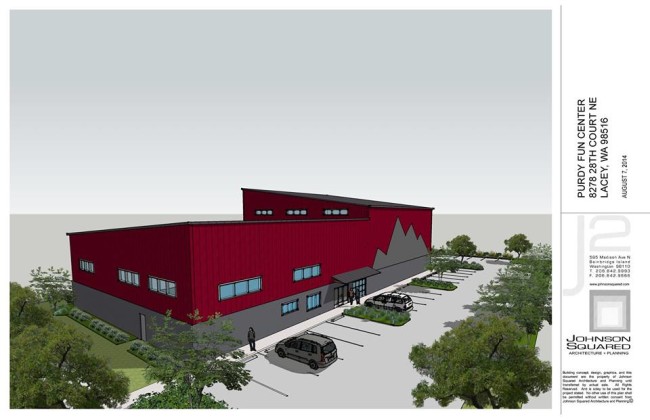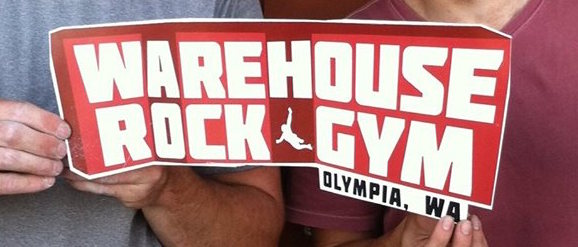
by Tino Fiumara
Olympia, WA is a beautiful, cultural center on the Puget Sound that boasts one of the best views of iconic Mt. Rainier that a state capital could offer. One can imagine that there are multiple state of the art climbing gyms for the area’s 300,000 people to chose from…or not. The reality is that there is only one quaint gym housed in an aging turn-of-the-century lumber mill.
Now there is an incoming corporation that wants to bring a state of the art facility to a demographic that can realistically handle only one sizable, modern gym. Only one of these two will survive.
To survive the older gym will have to complete an expensive remodel to bring their gym up to modern standards – but they don’t have the cash on hand to do that. The incoming gym will be state of the art, but would struggle through the first years as they compete with the established hub of the climbing community. Here lies the competitive conundrum that so many cities in the US will start to face now that opening a climbing gym is a recognized financial pursuit – a conundrum that can also fractionalize the local climbing community.
So how did the new Purdy Fun Climbing Corp and the established Warehouse Rock Gym, LLC solve this problem in Olympia? Simply – they decided to work together. Uniting their enterprises through a buyout where the existing membership interest of the LLC was valued and swapped for shares in the new corporation. The new entity gains instant cash flow, membership, and brand recognition. The old gym is able to grow into the modern age and keep spreading the magic.
The Backstory of Warehouse Rock Gym
First conceived in 2002, but opened in 2004, the Warehouse Rock Gym was started as an add-on element of a large local outdoor retailer, Alpine Endeavors. Whether or not it would be profitable was anyone’s guess. Heavy on payroll, the Warehouse almost didn’t make it through the first few years – “note to budding gym owners, control your overhead”, advises Jim Hyer, who founded the gear shop and climbing gym combo. Hyer is now a principle at Percival Consulting, and a business consultant.
Luckily the outdoor store was a 25% owner of Warehouse Rock Gym and could float the summer income shortages – to the tune of $25,000 – until winter revenues could refill the coffers.
Then, when the national economy was sinking in 2009, the oddest thing happened. The Warehouse Rock Gym started to explode – not in flighty day-pass revenue, but in memberships. It is key here to say that the Warehouse didn’t offer a membership shorter than 3 months. “People couldn’t afford Disneyland, but they could afford a membership”, Jim Hyer explains.
The Warehouse finally started paying dividends to the four owners and things seemed good for a few years. Now the 4,000 square foot gym was booked solid for parties, pulling in almost $80k annually from memberships and taking in about $250k annually in gross revenue. The annual membership number doesn’t even include pre-paid monthly memberships because Warehouse didn’t employ an EFT system until just recently. Already at capacity, the Warehouse was poised for a growth spurt with no expansion plan in the process.
When asked about initial succession planning Jim Hyer replied, “the original Warehouse Rock Gym business plan did not have any succession planning, or plans beyond 10 years. We never envisioned past being successful. That didn’t come until 2014, with three solid years of paying dividends behind us. (Then) the gym had planned an expansion in the adjacent warehouse space.”
Then things got interesting again. In 2014, the outdoor retailer dissolved their LLC, moved out of the building and had to sell their 25% interest in the Warehouse Rock Gym. This also meant that Warehouse had to foot all of the overhead for the aging building. This is when Mike Boyer enters the story.
Enter Purdy Climbing Corp
Boyer is a mild-mannered public service employee that develops and manages customer service oriented grant programs for the Washington State Department of Ecology. Boyer and his wife decided that their passions for climbing, fitness, the outdoors, customer service and dogs could be passionately manifested in a single objective – an indoor climbing gym. Since dogs aren’t normally allowed, they named their company after their dog, Purdy.
The Purdy Fun Climbing Corp didn’t end up taking that 25% interest in the Warehouse – an old investor of Alpine Endeavors bought it. Shortly thereafter, Boyer had a change of heart and came back for the 25% deal, but it was too late. But this is when more fruitful conversations started.

Boyer knew Warehouse was overcapacity and needed a major renovation, so he put together a plan to purchase 100% of the Warehouse Rock Gym at a fair price that included trading stock in the Purdy Fun Climbing Corp. “From a business standpoint, both companies could achieve much more together than we could independently,” Boyer said. “In an emerging market, we could offer much more climbing, but still keep the indoor climbing community united under a single roof,” relays Boyer.
The Warehouse Rock Gym has built a strong community among the local climbers, but lacked funds for a needed expansion. “I had spent over three years developing plans to develop property and build a new indoor climbing facility. Purdy Fun Climbing is all about building community. It made good business sense to combine our resources.” continues Boyer.
Keeping the Band Together
Boyer outlined future roles for all of the key players and, like any good story, the team stays together for future success. The former Warehouse Rock Gym owners serve on the Purdy Fun Climbing Board of Directors. Joe Hyer, owner of the former Alpine Experience and former business manager for the Warehouse Rock Gym, is the contracted bookkeeper and business consultant for the Purdy Fun Climbing Corp. And Esteban Pinto, Purdy’s new Operations Director, currently manages the Warehouse Rock Gym.
As owner and president, Boyer will try to spend considerable time interacting with customers in the gym. “My favorite job is belaying kids and talking with their parents. I love to see the smile on kid’s faces after they’ve climbed to the top of walls. It’s the same smile I had on my face when I first climbed to the top of a wall in Eldorado Canyon, thirty years ago,” says Boyer.
Purdy Climbing Corp plans to break ground August of 2015 next to a green space – a rainwater reclamation site – that has trails (so the dogs are included). Elevate Climbing in Seattle was contracted to integrate the building and climbing wall in a cost-effective and balanced design.
To promote community, Purdy is leaving the middle of the building completely open so it can be used as a social center for climbers. Ian Anderson, from the So Ill Climbing Gym, helped design the HVAC/filtration and LED lighting system to provide climate control and good air quality – two things lacking at Warehouse’s current facility. The city has approved the plans and the project will be funded with an SBA loan package.
In the end, the competitive struggle that could put a schism in the local climbing community in Anytown, USA was averted in Olympia, WA. Current business will continue to prosper and a modern era will be ushered in.
For all of the budding climbing gym entrepreneurs that think they can knock that old school sweat box of a gym to the curb, read this article again. Take note of the significance of collaboration, that not everything has to be a head-on competition where only the fittest survive. Much like climbing a rock, it can be about working with the existing features and not about fighting your way through, but synerizing your way to success.

Climbing Business Journal is an independent news outlet dedicated to covering the indoor climbing industry. Here you will find the latest coverage of climbing industry news, gym developments, industry best practices, risk management, climbing competitions, youth coaching and routesetting. Have an article idea? CBJ loves to hear from readers like you!







